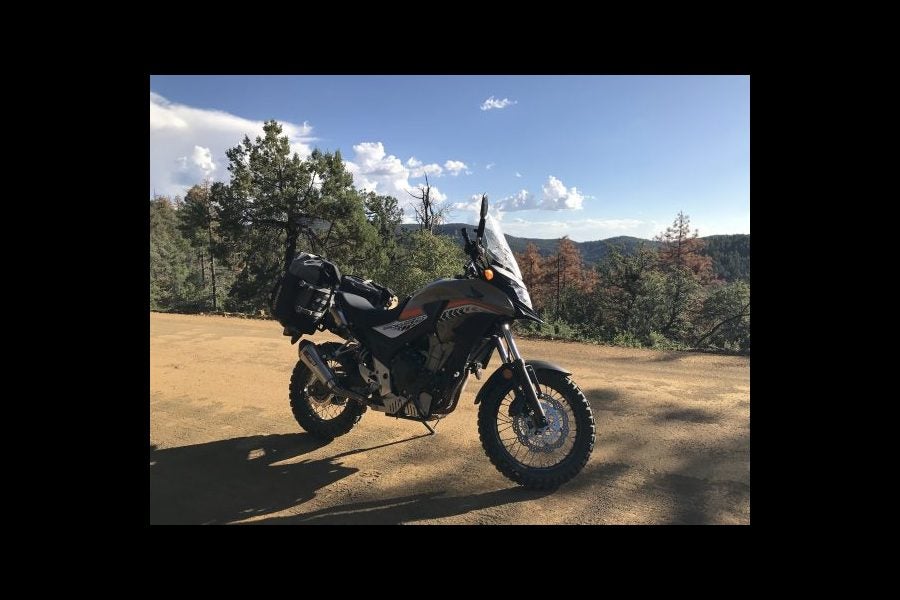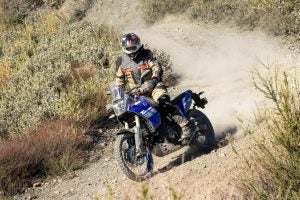In 2019, Honda did something that we don’t always see from the Japanese OEMs: It listened to adventure bike-buying customers! More specifically: Honda took its popular CB500X all-road bike and gave it a bit of a suspension update, and a 19-inch front wheel. That change was quite welcome—but what if you’d bought a bike from the original 2013-2018 production run, with a lame 17-17 wheelset?
The answer was simple, but expensive-ish: You bought yourself a Rally Raid kit, as seen on this bike here.
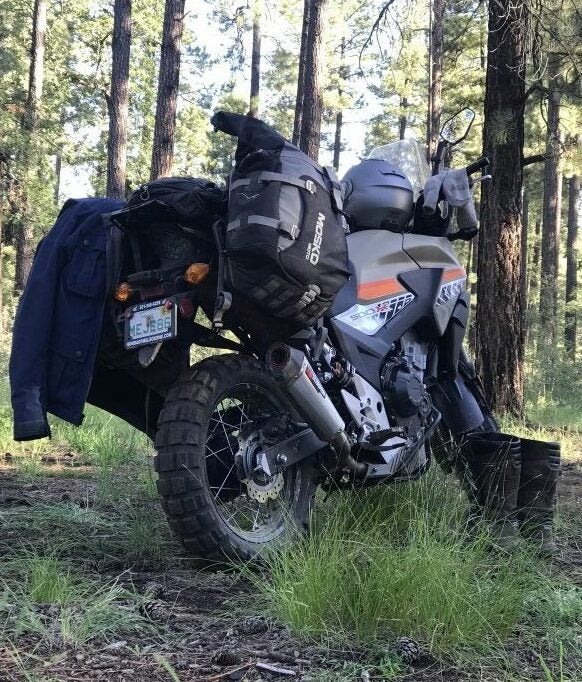
Knobby tires on spoked rims, a luggage kit, and a new rear shock make this bike much more off-road friendly. Photo: Cro59
Budget-friendly machine
The global financial meltdown that’s shaped this generation happened in 2008, but Honda was a bit slow to respond. It launched its affordable middleweight 500 lineup in 2013, and even then, the sporty CBR500 and CB500F came first. The travel/adventure-oriented CB500X came months later. It was basically the same machine as the bikes that preceded it, but with slightly different bodywork, a bit more front suspension travel, and 17-inch wheels fore and aft.
What? Why? Why wouldn’t Honda put a 19-inch front on the bike, the journos asked. And so did buyers, but they bought these bikes anyway. While the CB500X was never in any danger of eclipsing the KLR650 or DR650 in popularity, Honda had no trouble selling them. It wasn’t because the bike was especially cheap, or light, or powerful. It was none of those things, but it was cheap enough, light enough and powerful enough that a lot of riders saw it as an easy entry-level machine, maybe somewhat similar to a V-Strom 650 but for even less money.
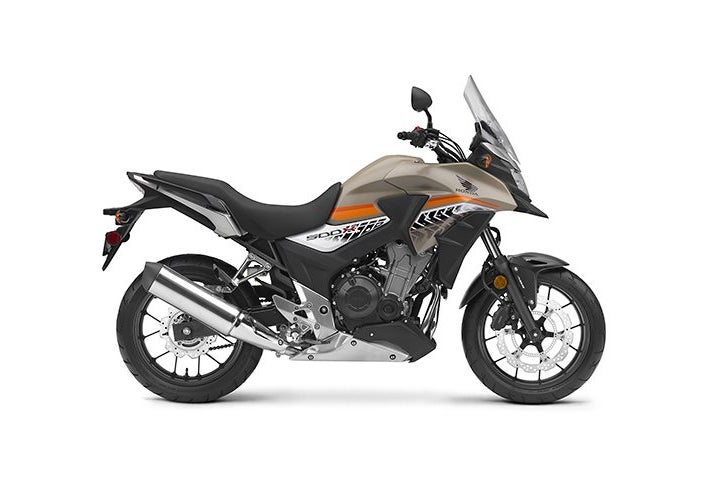
Here’s what this machine would have looked like in its original trim. Photo: Honda
When Motorcycle.com reviewed the machine a decade ago, they called it “The diminutive (but not really) Adventure-Tourer.” Test pilot Tom Roderick liked the all-around capability, the big-bike feel, the price ($6k, add $500 for ABS), the fuel economy, and the handling in tight corners. On the other hand, he panned the suspension (a common complaint) and freeway passing power. The comments at that time called him out for that—surely 45ish hp was enough to pass safely for a 430-lb bike? Well, max torque was only 29.5 lb-ft at 7000 rpm, so with a full load of luggage, even the Wee-Strom would feel considerably more muscular!
Having said that: I remember riding a CBR500, which has the same engine, down a rainy four-lane highway around this same time. I was loaded with luggage for a two-week trip, and still managed to pass a car at more than 100 mph, uphill. And I thought to myself at that time: “Surely, this has to be enough horsepower for any practical purposes.”
And so thought a lot of the moto-public. But while they felt the 500X’s power was adequate, a lot of buyers disliked the small front wheel and chintzy suspension, just the same as Mister Roderick of MO. That’s where Rally Raid came in!
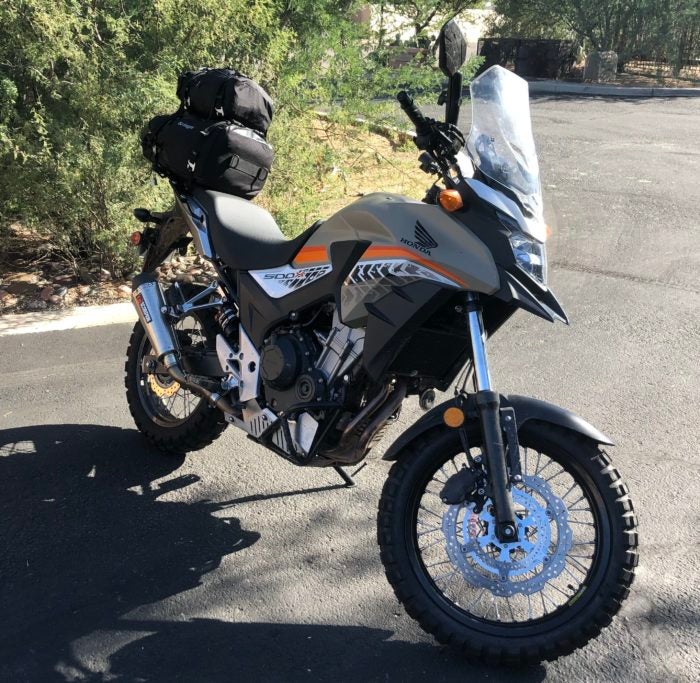
These are expensive parts, so buying a bike with them pre-installed will often save you time and money. Photo: Cro59
The right parts, if you can afford them
Rally Raid Products was a UK-based business that saw a lot of potential in the little adventure bike. These enterprising Brits set about offering remedies to the Honda’s inadequacies. The most important parts were a new shock, new front springs, and a spoked 19-17 wheelset. While this would still not turn the bike into a dual sport along the lines of Honda’s XR650L, it did make it a much better machine in the dirt.
Rally Raid offered its upgrades individually, but most buyers opted for either the Level 1 or Level 2 kit. As you’d expect, the Level 1 kit was a collection of small upgrades, and the Level 2 kit turned the Honda into a much more competent machine, and was correspondingly more expensive. Check out the current price list here—the Level 2 shock is twice the cost of the Level 1 swap-in unit!
The naysayers often wondered why you wouldn’t just buy a new bike with better components as stock, instead of upgrading your Honda, but that didn’t stop people from buying the Honda and then shopping at Rally Raid.
This bike here
This machine is a 2016 model for sale in ADVrider’s Flea Market, by inmate @Cro59. The advert says:
Located in Tucson, AZ.
Approximately 10,000 miles.
Rally Raid Level 2:
– Rear shock
– Front springs
– Spoke wheels
– Skid plate
– Luggage rack
Includes spare filters, new rear tire, bark busters (not installed), and more.
$5,500.
More photos and details to follow.
I built this bike to ride off road and took it off road, so it has its share of scratches. Imperfections are cosmetic, nothing structural.
My interests have moved to sailing, so the bike has to go.
It looks like it could be a practical and affordable fly-and-ride. While $5,500 bucks is a lot of money for this machine (almost the as-new MSRP), those upgrades would add thousands to the price, not to mention the cost of installation. Set up as it is now, this should be a practical, fuel-sipping machine that would provide the new owner with many, many miles of practical usability.


